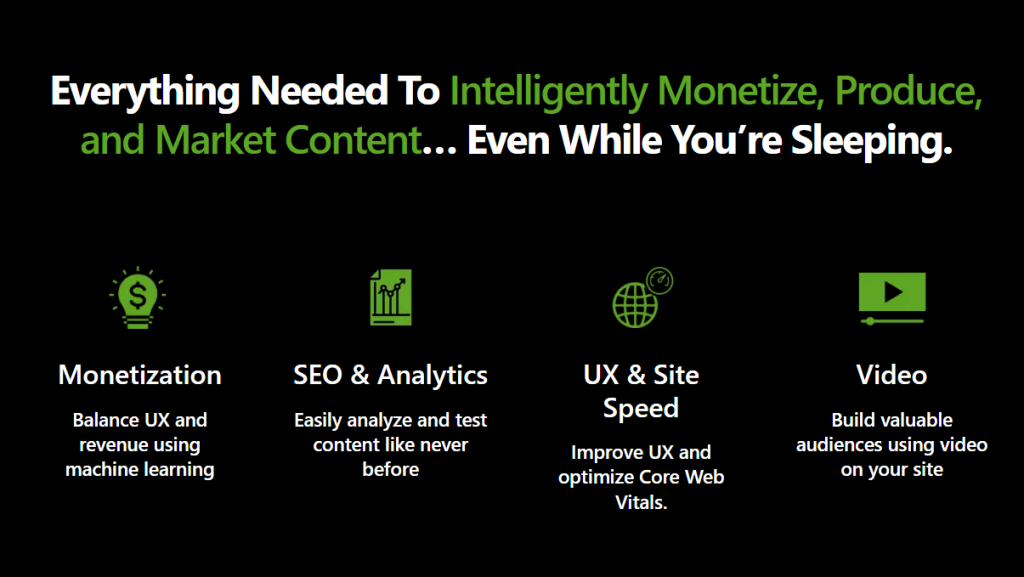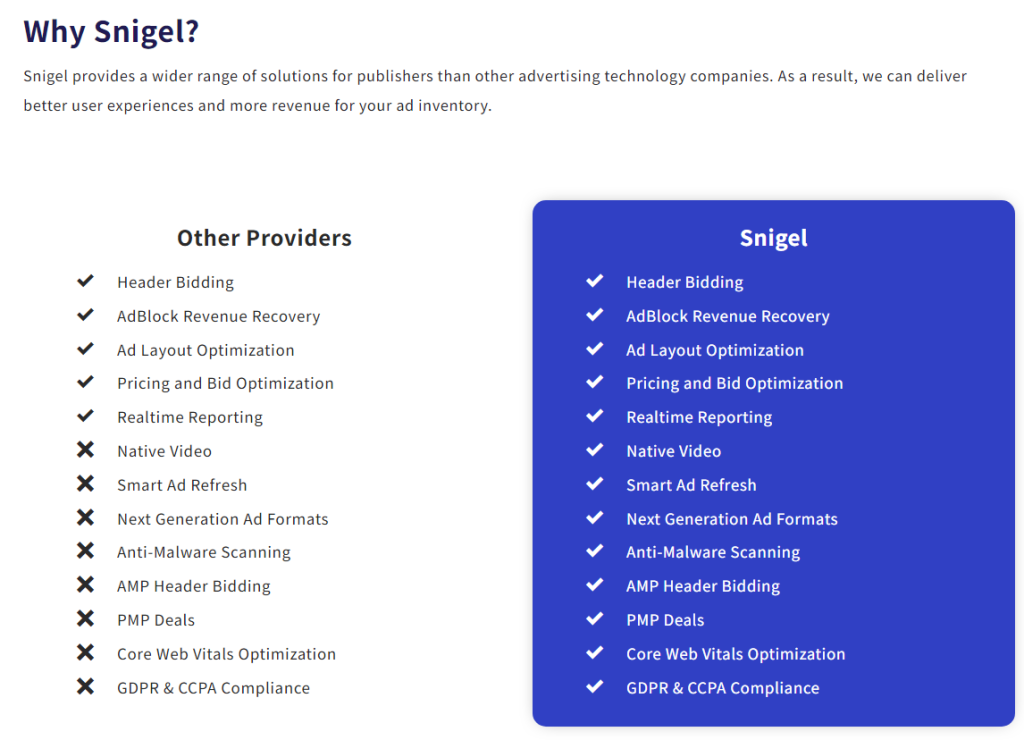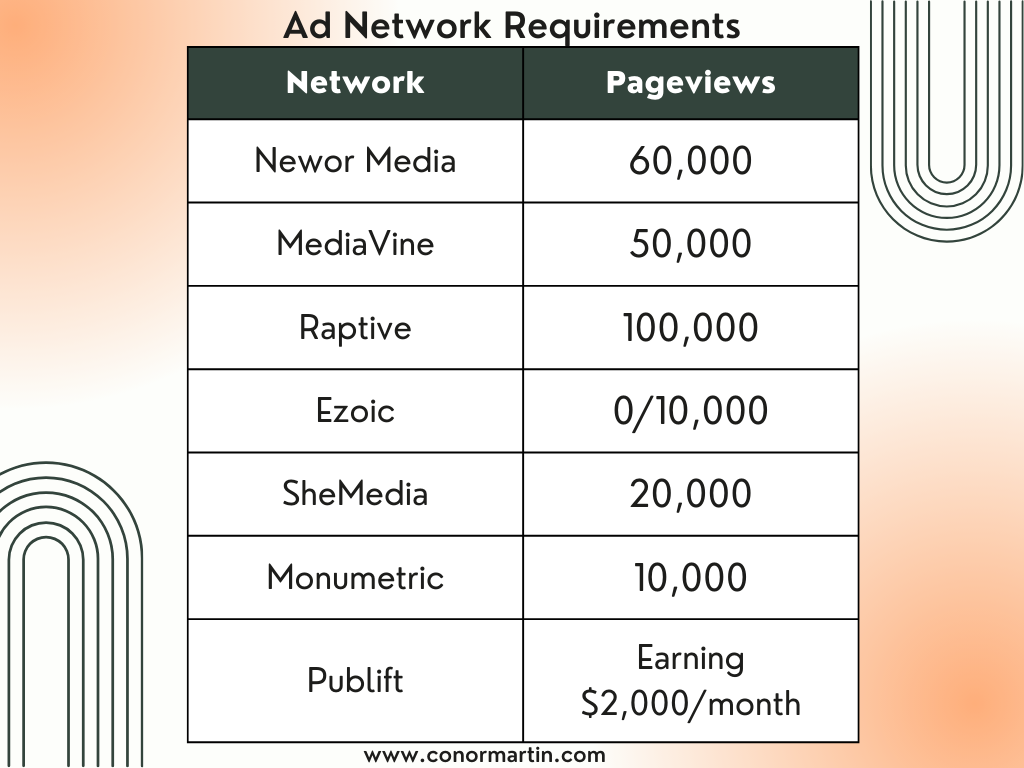If you’re a publisher or advertiser looking for an ad network, you may have come across Ezoic and Snigel. Both platforms offer AI-driven ad optimization and monetization services. However, there are some differences between the two that may make one a better fit for your needs.
Ezoic is a huge ad network that can be a good start for small publishers wheras Snigel is only for large publishers who get more than 2 million pageviews per month. If you are looking for something in between check out Newor Media.
[lasso ref=”apply-to-newor-media-newor-media-professional-ad-management” id=”1670″ link_id=”3393″]
Ezoic

Ezoic is a self-serve platform that uses AI to optimize ad placement and revenue. It offers tools for publishers to test and optimize their site’s layout and ad placement. Ezoic also provides access to premium ad networks, which can increase ad revenue. The platform is designed for publishers of all sizes, from small blogs to large media companies.
Snigel

Snigel, on the other hand, is a managed service that uses AI to optimize ad revenue and user experience. Snigel offers a team of experts who work with publishers to optimize their site’s layout and ad placement. The platform also provides access to premium ad networks and offers a range of ad formats, including display ads, native ads, and video ads. Snigel is ideal for publishers who want a hands-off approach to ad optimization.
Ad Network Comparison
When it comes to choosing an ad network, it can be overwhelming to sort through all the options available. In this section, let’s compare Ezoic and Snigel in terms of ad formats and ad inventory.
Ad Formats
Ezoic and Snigel both offer a variety of ad formats to choose from. Ezoic offers display, native, and video ads, as well as adhesion and in-image ads. Snigel also offers display, native, and video ads, as well as push notifications and pop-unders.
Both ad networks have customizable ad formats, allowing you to choose the size, placement, and frequency of your ads. Ezoic’s ad testing technology can also help optimize your ad formats for maximum revenue.
Ad Inventory
Ezoic and Snigel both have access to a wide range of ad inventory. Ezoic partners with different ad networks, including Google AdSense, Media.net, and Bing. Snigel also partners with ad networks including Yahoo! and Google.
Both ad networks offer real-time bidding (RTB) technology, which allows advertisers to bid on your ad inventory in real time, increasing the likelihood of higher bids and revenue.
Ad Formats and Types
When it comes to ad formats and types, both Ezoic and Snigel offer a range of options to publishers. Let’s take a closer look at what each platform has to offer.
Ezoic
Ezoic’s Ad Tester allows publishers to test different ad formats and sizes to find the best-performing options for their website. Some of the ad formats available include:
- Display ads: These are the most common ad type and include image and video ads of various sizes.
- Video ads: These ads play before, during, or after video content.
- Native ads: These ads blend in with the website’s content and are designed to look like editorial content.
Ezoic also offers access to next-generation ad format technology, including adaptive ads. These ads adjust their size and layout based on the device and screen size of the user.
Snigel
Snigel offers a fully customized AI-powered ad stack and ad strategy for publishers. This means that the ad formats and types used on each website are tailored to its specific needs and audience. Some of the ad formats available include:
- Display ads: These are the most common ad type and include image and video ads of various sizes.
- Video ads: These ads play before, during, or after video content.
- Native ads: These ads blend in with the website’s content and are designed to look like editorial content.
Snigel’s ad experts work with publishers to determine the best ad formats and types for their website and audience. This personalized approach can lead to higher engagement and revenue for publishers.
Ad Optimization and Management
When it comes to ad optimization and management, both Ezoic and Snigel have a lot to offer. Ezoic’s AI-powered ad engine helps you test and optimize your ad layout, while Snigel provides a dedicated ad management expert who creates and manages a customized ad strategy for you.
Ezoic’s ad tester allows you to test different ad layouts and sizes to find the ones that perform best on your site. This can help you increase revenue while maintaining a good user experience. Ezoic also offers adaptive ads, which adjust in real-time to fit the size and layout of each user’s device.
On the other hand, Snigel provides a custom ad strategy that is tailored to your specific site and audience. This includes ad layout optimization, where the expert will work with you to find the best ad placement and size for your site. Snigel also offers analytics and reporting to help you track your ad performance and make data-driven decisions.
In terms of ad management, both Ezoic and Snigel offer solutions to help you manage your ads and optimize your revenue. Ezoic’s ad management platform allows you to control your ad placements, view analytics, and manage your ad partners all in one place. Snigel, on the other hand, takes care of all the ad management for you, so you can focus on creating great content for your site.
Traffic Requirements and Target Audience
When it comes to traffic requirements, Ezoic and Snigel have different approaches. Ezoic has no traffic requirement, making it a popular choice for smaller websites and blogs. On the other hand, Snigel have a minimum traffic requirement of 2 million pageviews per month or they say that they require that your website is at least making $50 USD per day.
Check out this table below for the traffic requirements of Ezoic and other popular ad networks like Newor Media and MediaVine:

In terms of target audience, both Ezoic and Snigel cater to publishers and niche bloggers who want to monetize their website traffic through ad revenue. Ezoic is known for its AI-powered ad optimization technology, which helps publishers increase their ad revenue without sacrificing user experience. Snigel, on the other hand, provides a dedicated ad management expert who creates, implements, and manages a fully customized AI-powered ad stack and ad strategy for you.
Revenue Generation
When it comes to revenue generation, both Ezoic and Snigel offer revenue-sharing models. Ezoic’s model is based on a 90/10 revenue split, where publishers receive 90% of the ad revenue generated by their website. Snigel, on the other hand, offers a more flexible revenue share model, with the ability to negotiate a custom revenue share percentage.
One advantage of Ezoic’s revenue-sharing model is that it is straightforward and easy to understand. Publishers know exactly how much they will earn from their ad revenue, which can help them plan and optimize their website accordingly.
Snigel’s custom revenue share model can be beneficial for publishers who have a high volume of traffic or unique advertising needs. By negotiating a custom revenue share percentage, publishers can potentially earn more revenue from their website.
Both Ezoic and Snigel offer tools and features to help publishers increase their ad revenue. Ezoic’s AI-powered Ad Tester and Layout Tester can help optimize ad placement and improve user experience, leading to higher ad revenue. Snigel’s AI bidder optimization can also help improve ad performance and increase revenue.
Header Bidding and AI Bidding
When it comes to ad monetization, header bidding has become increasingly popular among publishers. It allows publishers to offer their ad inventory to multiple demand sources simultaneously in real-time, which can increase the cost-per-mille (CPM). Ezoic and Snigel both offer header bidding solutions, but they differ in their approach.
Ezoic offers a server-side header bidding solution, which means that the auction takes place on Ezoic’s servers rather than on the user’s browser. This approach can improve page load times and reduce the risk of ad fraud. On the other hand, Snigel provides AI bidder optimization that switches bidders between server-side and client-side header bidding (depending on their performance). This approach can help optimize bids and increase revenue.
In addition to header bidding, Snigel also offers bid shading, which is a technique that allows advertisers to bid lower on impressions that are less likely to convert. This can help increase the efficiency of ad spend and improve ROI.
Analytics and Reporting
Both Ezoic and Snigel offer robust solutions to help you track your website’s performance and optimize your ad strategy accordingly.
Ezoic’s platform includes built-in analytics tools that provide you with detailed insights into your website’s traffic, user behavior, and ad performance. The platform integrates with Google Analytics, allowing you to view your website’s metrics alongside your ad revenue data. Ezoic also offers a customizable dashboard that lets you monitor your website’s performance in real-time and track your progress over time.
Snigel, on the other hand, provides publishers with a comprehensive dashboard that gives you full visibility into your ad revenue, website traffic, and user engagement. The platform integrates with Google Analytics and provides you with detailed reports on your website’s performance, including pageviews, bounce rates, and session durations. Snigel’s dashboard is user-friendly and easy to navigate, making it easy to track your progress and make data-driven decisions.
Support and Resources
When it comes to choosing an ad monetization platform, having access to reliable support and resources is essential. Both Ezoic and Snigel offer different levels of support and resources to their users.
Ezoic provides their users with a dedicated account manager who can help with any issues or questions that may arise. They also have a comprehensive knowledge base and support forum where users can find answers to common questions and troubleshoot issues on their own.
On the other hand, Snigel takes a more hands-on approach to support by providing their users with a dedicated ad management expert who creates, implements, and manages a fully customized AI-powered ad stack and ad strategy for them. This means that users can rely on Snigel’s team to handle all aspects of their ad monetization, from ad placement to optimization.
In terms of resources, Ezoic offers a wide range of resources including webinars, case studies, and whitepapers. They also have a blog that covers topics related to ad monetization and website optimization. Snigel, on the other hand, offers a more limited set of resources, with a blog that covers topics related to ad monetization and a knowledge base that provides answers to common questions.
Additional Features
When it comes to additional features, both Ezoic and Snigel offer a wide range of tools and services to help publishers maximize their ad revenue. Here are some of the features that are worth noting:
- Adblock Revenue Recovery: Both Ezoic and Snigel offer adblock revenue recovery tools that help publishers recover lost revenue due to adblockers. Ezoic’s tool, called Ad Tester, allows publishers to test and optimize their ad layouts for adblock users, while Snigel’s solution involves using a custom ad stack that bypasses adblockers.
- AdConsent: AdConsent is a feature that helps publishers comply with GDPR and other privacy regulations. Snigel offers a built-in AdConsent tool that allows publishers to obtain user consent for personalized ads, while Ezoic’s solution involves using a third-party consent management platform.
- Leap: Ezoic’s Leap feature is a machine-learning tool that helps publishers improve their website’s user experience. Leap analyzes user behavior and makes recommendations for improvements, such as reducing page load times or improving mobile responsiveness.
- Humix: Humix is a feature offered by Ezoic that uses AI to optimize ad placements and improve ad performance. Humix analyzes user behavior and adjusts ad placements in real-time to maximize revenue.
Final Thoughts
Both Ezoic and Snigel offer benefits for publishers and advertisers. Ezoic’s self-serve platform gives publishers more control over their ad optimization, while Snigel’s managed service offers expert support and a hands-off approach. Both platforms use AI to optimize ad placement and revenue, which can increase ad revenue for publishers.
In short, Ezoic provides a more self-service approach, while Snigel takes a more hands-on approach with dedicated ad management experts.
Whether you prefer a more hands-on approach or want someone else to take care of it for you, both platforms have something to offer.
